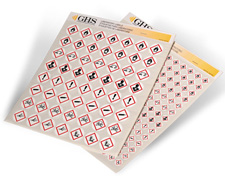



Find all of your laboratory and workplace safety supplies at Safety Emporium!
 Ketone |
 Glossary Index |
 Lachrymator |
| MSDS Topics |
Free Sites | FAQ's | Regulations | Glossary | Software | Suppliers |
| Books | Forum | Poll | Fun stuff | Quiz | Store | |
| Understand your MSDS with the MS-Demystifier | Search ALL our MSDS info | |||||
Consult our more extensive discussion of ketones for details on their chemical structure, naming and more.

Get your GHS-compliant labels and signs from Safety Emporium.
Ketones are a normal byproduct of fat metabolism (the breaking down of fat into energy). Normally, your body is efficient at removing these, but when certain enzymes are absent or damaged, the concentration of ketones in the body can build up. Ketosis indicates a blood ketone concentration between 0.3 and 7.0 mmol/L and ketoacidosis reflects levels of 7.0 mmol/L or higher. Ketoacidosis gets its name because high blood ketone levels lower the pH of your blood to 7.3 or lower. Severe and/or prolonged cases of ketoacidosis can lead to coma and death if not properly treated.
Certain individuals are predisposed towards ketosis or ketoacidosis. For example, those with diabetes have insufficient insulin levels and their bodies have difficulty processing glucose (sugar). If a diabetic does not alter his or her diet to reduce sugar intake and/or take additional insulin, their body will break down fat, leading to a rise in ketone levels. The complexities of diabetes and ketoacidosis are beyond the scope of this discussion; see the links under Further Reading for more information.
Popular low-carbohydrate diets (such as Atkins) encourage the breakdown of fat and can induce so-called dietary ketosis, but this condition is generally not harmful provided the individual is otherwise healthy and stays well-hydrated.
Ketones can be excreted through the urine and those that are volatile (such as acetone) can be expelled through the lungs. Diabetics can be mistaken for being drunk by the odor on their breath, and acetone being expelled through the lungs can give a false positive result on early model breathalyzers. However, don't expect to escape a ticket as driving while impaired (due to low blood sugar) is still a traffic offense whether you are drunk or not.

This guide to safer laboratories and maker spaces is just one of many lab and safety items available at Safety Emporium.
This term is mostly likely to appear on a Safety Data Sheet as a symptom of exposure, particularly by ingestion as well as inhalation. Certain chemicals can directly or indirectly cause the formation of excess ketones in the body. This should appear as a symptom of exposure under Section 11 (toxicological information) of the SDS.
Understand the dangers of the chemicals you are working with by carefully reading the labels and SDS sheets before you begin work. Section 8 (exposure controls/personal protection) of the SDS will suggest proper precautions when working with a particular substance.
See also: alcohol, chemical formula, ketone.
Additional definitions from Google and OneLook.
Entry last updated: Monday, January 2, 2023. This page is copyright 2000-2025 by ILPI. Unauthorized duplication or posting on other web sites is expressly prohibited. Send suggestions, comments, and new entry desires (include the URL if applicable) to us by email.
Disclaimer: The information contained herein is believed to be true and accurate, however ILPI makes no guarantees concerning the veracity of any statement. Use of any information on this page is at the reader's own risk. ILPI strongly encourages the reader to consult the appropriate local, state and federal agencies concerning the matters discussed herein.